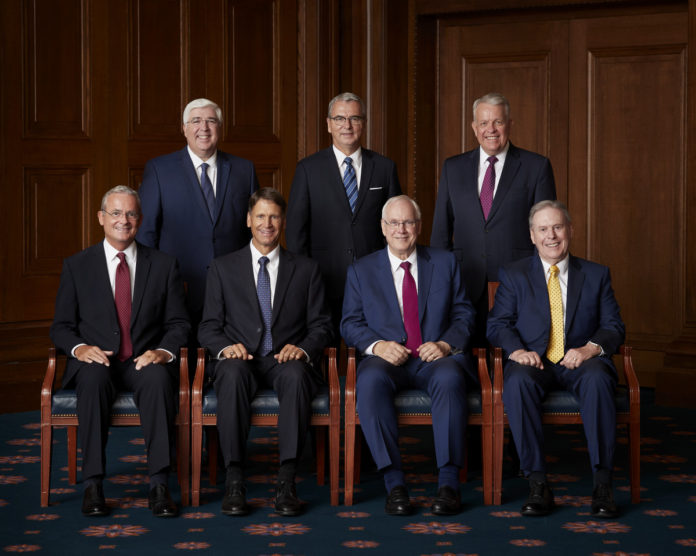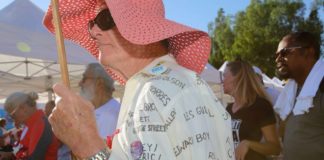This article was first published as the ChurchBeat newsletter. Sign up to receive the newsletter in your inbox weekly.
The church announced new leadership assignments on Wednesday, and while two of them had been announced at general conference 18 days ago, they still begged a question.
What do members of the Presidency of the Seventy do?
For perspective, I spoke with Elder Marlin K. Jensen and Elder Steven E. Snow, who each served in the Presidency of the Seventy for The Church of Jesus Christ of Latter-day Saints.
Elder Snow succeeded Elder Jensen as the Church Historian/Recorder in 2012, when Elder Jensen received emeritus status. Elder Snow achieved emeritus status in 2019.
“The one thing I really learned there was just how seriously the leaders of the church, the senior leaders, how seriously they take the work,” Elder Jensen said. “That’s so inspiring to me. It was emblematic of their faith in the cause, of their belief in the cause, just to see how seriously they took it, the excellence with which they did it, the conscientiousness of what’s done there.”
Speaking of all the general authorities, he added, “Where else would you find a group of people that could have done anything with their lives, really, that would put all of that on the shelves and come there and work, literally, harder than you’ve ever worked in your life?”
Why it matters now
The Presidency of the Seventy is the third-highest ranking leadership body in the church after the First Presidency and the Quorum of the Twelve Apostles. It consists of seven leaders known as the seven presidents of the Seventy. On April 3, two changes to the presidency were announced:
- Released: Elder Terence M. Vinson, who turned 70 on March 12, and Elder Robert C. Gay, who will turn 70 on Sept. 1. General Authority Seventies typically are granted emeritus status at age 70 and released during the October general conference.
:no_upscale()/cdn.vox-cdn.com/uploads/chorus_asset/file/22460662/merlin_2860939.jpg)
- Called: Elder Paul V. Johnson, 66, the former longtime commissioner of the Church Educational System, and Elder S. Mark Palmer, 65, a native of New Zealand who had been serving as the president of the church’s Africa South Area.
Note: Seven members of the Quorum of the Twelve Apostles previously served in the Presidency of the Seventy, including acting quorum President M. Russell Ballard and Elders Quentin L. Cook, D. Todd Christofferson, Neil L. Andersen, Ronald A. Rasband, Gerrit W. Gong and Ulisses Soares.
Who supervises the Presidency of the Seventy
“The Seventy work under the direct supervision of the Twelve,” Elder Jensen said, citing Doctrine & Covenants 107:25-26, 34.
Elder Jensen shared a quip made by the late President Boyd K. Packer when he was asked about that section of Latter-day Saint scripture. The question was, “What’s the difference between the Twelve, who in this section are called ‘special’ witnesses of Jesus Christ, and the Seventy, who are called ‘especial’ witnesses?”
“The only difference,” President Packer said, “is an ‘e.’”
In fact, that section outlines the Twelve’s supervisory role, which is taken seriously. Elder Jensen recalled that he was one of the seven presidents of the Seventy in the late 1990s when a change was made: The presidency began to join the weekly Tuesday meeting of the Quorum of the Twelve.
The first time they joined the meeting, Elder Jensen said he remembers filing into a conference room in the Church Administration Building. There, the Twelve sits in what he described as a horseshoe semicircle.
At that first meeting, the seven presidents all sat down and President Packer, who was in the Twelve, said to the late Elder L. Aldin Porter, who was the senior president of the Presidency of the Seventy at the time, “What do you have for us today?”
Elder Jensen said he has never forgotten Elder Porter’s response.
“President Packer,” he said, “you are the Twelve. We are the Seventy, what would you have us do?”
“It’s one of those little moments that will never get written down in church history,” Elder Jensen said, “but I don’t think I’ve ever felt more strongly the power of the priesthood and the power of the leadership of these two of the three leading quorums of the church as I did in that moment, but it does beautifully express that the seven presidents do essentially what the Twelve wants to do and has them do and asks them to do.”
Meetings and responsibility of the Presidency of the Seventy
Elder Jensen said the presidency meets weekly:
“They have a presidency meeting in a room in the Church Office Building. They go over weekly sometimes to the Salt Lake Temple, where there’s a meeting room for the Twelve and a meeting room of the seven presidents and then a meeting room large enough for both the Quorum of the Twelve and the First Presidency to meet together.
“I remember the first time I went to the temple I was overwhelmed that I was in a room where B.H. Roberts and Milton R. Hunter and others had sat. It’s a historic room full of memories and the feeling that good things, important things were done there under the influence of the Lord.”
Elder Snow added:
“More often than not, the issues in our meetings arose from the field, and then we would address them and sometimes notify the Twelve. Sometimes they were big enough we took them to the Twelve. They gave us pretty much a hands-off policy for North America. They really do trust the Presidency of the Seventy to run the more mature stakes of the church. That kind of trust surprised me a little bit. They are so busy with the growing international nature of the church, you can understand why.”
Roles of the Presidency of the Seventy
The Presidency of the Seventy handle multiple administrative and ecclesiastical roles.
:no_upscale()/cdn.vox-cdn.com/uploads/chorus_asset/file/22460651/merlin_1018945.jpg)
“Generally stated, their duty would be to provide leadership to and supervise all the quorums of the Seventy, which includes the General Authority Seventies, of which there are now 99, and all 10 quorums of Area Seventies,” Elder Jensen said.
Here’s what that leadership and supervision looks like:
- Working under the supervision of a member of the Twelve, the seven presidents each has responsibility for one or more geographic areas of the church. “They are like a liaison to an area presidency or sometimes several area presidencies,” Elder Jensen said.
- Part of that responsibility for an area of the world is to make recommendations on the calling of new General Authority Seventies and Area Seventies. Those recommendations are forwarded to the Quorum of the Twelve, which considers them, and then taken to the First Presidency, which makes the decisions and issues the callings. Elder Jensen said:
“They become genuinely familiar with areas and they become familiar with the most significant leaders there, including the Area Seventy, which in a way is a training ground, kind of a farm club to put it in baseball terms, for General Authority Seventies. These men and women now have to come to the attention of those who extend these calls, and so as big as the church is and as far flung as it is, it always amazed me how knowledgeable the leadership in the church has remained about individuals.”
- The seven presidents work Tuesdays through Friday at noon in their offices in Salt Lake City, then travel with an Area Seventy companion to their normal weekend assignments presiding over stake conferences and the reorganization of stakes, Elder Snow said. Elder Jensen added:
“They travel widely. One of them will typically go with a member of the 12 in normal times and make an area visit once a year, where they spend several days within an area, visiting with the area presidency, visiting with the area staff, holding training meetings for local leaders. That’s become really important training and feedback. As big as the church is, there’s very good connection and very good knowledge on the part of the leaders of the church about what’s happening in any given area or region of the church.”
Lines of communication
The seven presidents of the Seventy conduct a weekly quorum meeting for the General Authority Seventies in Salt Lake City that is provided to all others around the world. Those meetings include direction and instruction and have also included church history lessons.
Those General Authority Seventies serving in area presidencies then hold regular area councils with all of the Area Seventies and the women who serve as Area Organizational Advisers.
The Area Seventies and Area Organizational Advisers then hold regular mission coordinating council meetings with the stakes under their responsibility, providing instruction and counseling with stake presidents and the mission president and temple president serving those stakes as well as area temple or family history or self-reliance leaders.
“It’s a really wonderful communication line,” Elder Jensen said.
:no_upscale()/cdn.vox-cdn.com/uploads/chorus_asset/file/22460671/merlin_739724.jpg)
Nature of the work
Elders Jensen and Snow said the presidents of the Seventy work long hours, many of them on administrative issues, but that the spiritual undergirdings of their efforts are rewarding.
“You’re talking about the souls of people and the Lord’s work and how to be a disciple of Christ,” Elder Jensen said. “That atmosphere made those callings worthwhile.”
The international nature of the members of the Seventy aids the First Presidency and Quorum of the Twelve in guiding a church with a presence in over 200 nations and territories with more than 16.6 million members.
“Many of the Seventy now come from all over the world,” Elder Jensen said, “so there’s a resource there that I think is a tremendous strength to the church and to the Twelve to have the seven presidents to turn to and to know that not only are they capable, but they have vast experience, they have knowledge of areas that sometimes they haven’t been to and don’t have.”
“I really admire these brethren who serve. It’s a big, big job and these are capable leaders,” Elder Jensen said.
See the full chart of general authorities recently released by the Church News.
My recent stories
Man charged with hate crime, arson in fire at Latter-day Saint meetinghouse in Missouri (April 20)
What I’m reading …
If I knew that Joseph Smith had commissioned a burial vault for himself, I had forgotten it. Now someone may have found the vault under a Nauvoo street.
I enjoyed this story: Why are Latter-day Saints shining in distance running? Here are a few possibilities.
Did you know Utah has 71,613 millionaires? Neither did I, till I read this story, which included a broad range of information about the recent sale of the Utah Jazz to Latter-day Saint philanthropy in the state to companies like Omniture and Qualtrics to Lamborghinis driving around Orem.
The NCAA moved a women’s volleyball tournament game so BYU wouldn’t have to play on a Sunday. That’s a positive application of religious accommodation.
Tunnels, fountains and roof repairs: Here’s the latest update on the Salt Lake Temple renovation.
How to watch BYU Women’s Conference next week.
Behind the scenes
:no_upscale()/cdn.vox-cdn.com/uploads/chorus_asset/file/22460932/merlin_720828.jpg)








